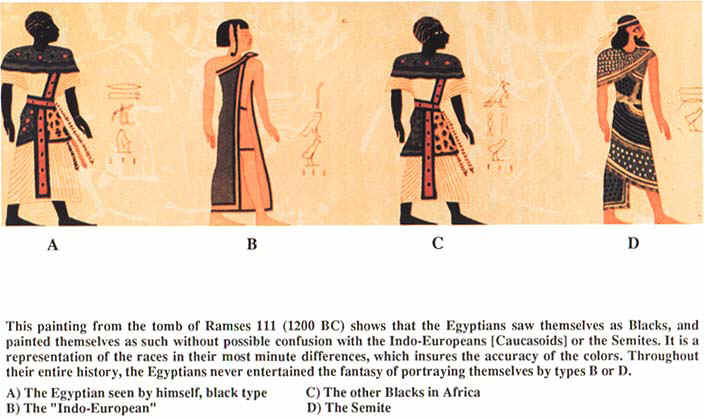One can clearly see
Rmt aka "the Kmtjw" or "the Egyptians" is written in hierglyphics and
Professor Mane Ampim supports this

Manu Ampim photo of 3 Egyptians ("Rmt") in tomb KV 11, 1994

By 1200 the non-black central asians started to enter turkey, iran, and india. We do not know which specific set it represents but probably it is turkey if this a true image and not a fabrication. Although turks are not semites, the egyptians would have no understanding of a term that didn't exist until the 1800s.
Quote:
| Were the people in Ancient Kemet the same groups of people who live Egypt today? No. Throughout Egypt’s history it had traded and fought with people from other countries. From around 750 BC the Nubian rulers, often called ‘The Kusheeites’ controlled Kemet and became its Twenty-fifth Dynasty. During this time Kemet enjoyed a renaissance, or return to earlier culture, as indicated by the promotion of the cult of the god Amun and also copies of earlier statues that were made by officials and the rulers. Later, the population was affected by the immigration of soldiers, traders and settlers from outside cultures, which included two Persian invasions in 525 BC and 343 BC; Macedonian Greeks who ruled Kemet from 332-30 BC; Romans, who took control of Kemet in 30 BC; and the Islamic settlement in AD 642. The Persians ruled Kemet from their own country. The Greek rulers, in contrast, lived in Kemet and adopted Egyptian culture and traditions; however, the language for administration was changed to Greek. The Romans, although absent rulers, had large numbers of their army in Kemet and were keen to promote Egyptian culture, albeit their own version of it. The last hieroglyphic inscription dates to AD 394, after this time Christianity, which had been present in Egypt from the first century AD, gradually became the dominant religion. Early Islamic rulers maintained cultural links with earlier Egypt, as seen by the minaret at the Mosque of Ibn Tulun in Cairo, which is in the form of the famous lighthouse of Alexandria and which dated to the third century BC. The language was changed to Arabic at this time and the religion to Islam. |
Quote:
| Were the Ancient Egyptians Africans? What colour was their skin? Yes. Egypt is in Africa and there are many cultural links to other African civilisations. If we look at the skin colour and also facial features on representations of Egyptians, many are what we would consider today to be Black African. Skin colours on temple and wall reliefs show ranges between dark brown and black, which is typical of what we see today with regard to people of Black African descent or origin. Furthermore, Nubians, a group who are accepted universally as Black Africans are, like their neighbours from Kemet, shown on reliefs with both jet black and red-brown skin and can be distinguished as Nubians by their short wigs. Many statues have lost their original skin colour. Sometimes colours were used by the Egyptians symbolically, so for example a statue of a god or royal person would painted gold to represent immortality. If we leave colour aside for a moment, we can also find out a great deal from looking at the facial features shown on Egyptian statues. Here, there can be no doubt that we are dealing with people who were African. Faces were broad with high cheekbones and the jaws are typically strong. The noses are also broad and the lips are generally full and fleshy in appearance. |
Quote:
| What does Kemet mean? Today, for obvious reasons, the name Kemet is associated with a more African-centred approach to looking at ‘Egypt’. For this reason the gallery that you are currently viewing is called Virtual Kemet. In adopting this name we hope to remind people that the ‘Ancient Egypt’ is an African civilization and that whilst the culture had contact with people from other civilizations, it was essentially African in its culture and well as its geographical placement. There are many links between ancient Egyptian and modern African culture, ranging from objects such as headrests to hairstyles such as the side lock, and this and other evidence support the idea that it was an African culture in addition to being geographically in Africa. For these reasons Egypt is seen by people of African descent as part of their cultural heritage and history. The concept of Egypt as part of Africa is not a new one. Some of the earliest travellers to Egypt came from the ancient cultures of Greece and Rome, including Greek philosophers, mathematicians, scientists, writers and poets who came to learn from the priests. To the Greeks and Romans, Egypt was an African country, and their artists depicted the Egyptians as Africans, with black skin and tightly curled hair, described by the Greek historian Herodotos in the fifth century BC as 'woolly'. |
Quote:
| Who was Cleopatra? Was she African? In the African-American oral tradition Cleopatra is often said to be an African woman. However, many academics who follow an African centred approach to Kemet ignore her. This is because Cleopatra’s family came to Kemet from Macedonia (region that is now part of northern Greece rather than the modern state with the same name). Her family had lived in Kemet for around 300 years before she was born and had enthusiastically adopted the traditional culture of Kemet and its religion and were proud to be shown as kings and queens of Kemet. Unlike earlier kings of Kemet, the Ptolemies (pronounced ‘Tolemees’) as they were known, usually took only one official wife but had many mistresses and concubines. These relationships often resulted in children who were illegitimate. Cleopatra and her father were born from such relationships and it has been suggested that both her mother and grandmother were native to Kemet and so Africans. This is because of the close ties between the royal family and the native elite in Kemet, and the fact that the Ptolemies had been in Kemet for so long at this time. Statues of Cleopatra suggest that the queen was part African and the Romans referred to her as an Egyptian, not as a Greek. |
Fitze William Museum
Look at that, it took a white man to tell you that Cleopatra was not even white despite being a "Greek". It cannot even be proven she was greek because her mother was black and her father and herself came from black Egyptian concubines. So even if you think the Greeks were white (I concept I prove false in my other thread) in antiquity; Cleopatra was not really a greek.
Her mother side was black africans. Her father was at most half greek or half white (assuming the greeks were white which is a BIG assumption at this point to begin with, after all, how do we know Ptolemy was not one of them Nubian mercenaries in greece that eurocentrics are always telling us about? Would it not make sense to send your nubian generals like Ptolemies into egypt if you were alexander?) But lets pretend Ptolemy was white.Ok Cleopatra would at best have a half white dad, like Obama, and a black mother, like Sasha and Malia, what white is stupid enough to try and claim Sasha and Malia Obama are white anglo saxons?



No comments :
Post a Comment
Note: only a member of this blog may post a comment.